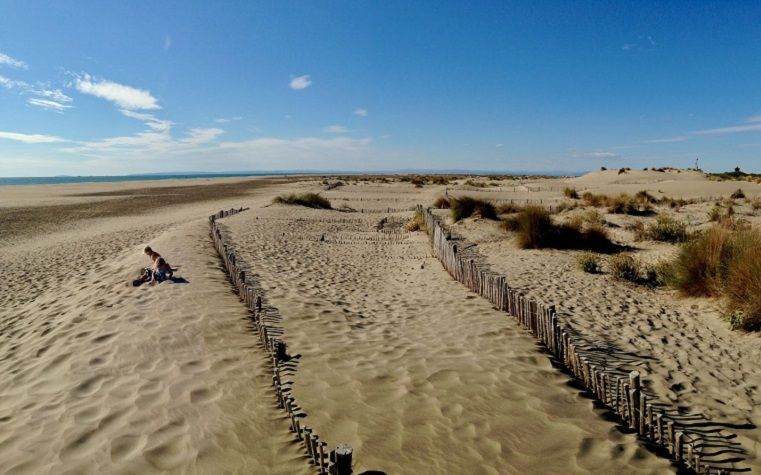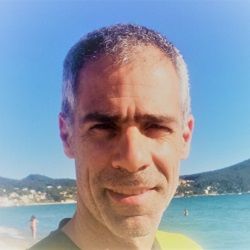
Coastal erosion and shoreline recession affect the majority of the world's coastlines and dunes are considered as natural protections against marine flooding. From a natural risk management perspective, when maintaining and/or constructing dunes to limit erosion and marine flooding, the traditional focus is on building high and wide dunes to limit flooding (Fernandez-Montblanc et al., 2020).
We propose a paradigm shift by calibrating lower, erodible dunes that allow marine flooding to promote sedimentation behind the dune by encouraging overwash mechanisms (Figlus et al., 2011). This mechanism allows the lagoons elevations to rise, thus indirectly counteracting the rise of the sea.
However, while the role of vegetation in stabilising a dune against wind transport is no longer in question, its impact on overwash deposits has yet to be defined. Indeed, the vegetation could slow down the overwash mechanisms (Bryant et al., 2019), which would then perhaps constitute a constraint for this sustainable engineering solution we propose to develop.
Nevertheless, the value of vegetation in preserving and containing dune sands also has many benefits and these need to be explored further. The approach we propose forces the acceptance of marine flooding to promote overwash deposition. However, the project needs to determine how often overwash, and thus also flooding, can be reasonably accepted and achieved.
This project is a true Nature-Based Solution that requires significant investment in fundamental research before it can be transferred to coastal engineering practices.
The Research Team

François Sabatier - AMU/CEREGE François Sabatier, Associate professor in Geography and Director of the Geography-Planning-Environment department of the ALLSH Faculty and director of the Master Specialisation COAST (Coastal Management and Vulnerabilities) of the GAED (Geography-Planning-Environment-Development) master's degree. His research focuses on the observation, quantification and prediction of coastal erosion for fundamental and applied research purposes. In this context, he has extensively studied the shoreline variations of several Mediterranean beaches, which led him to propose a shoreline recession forecasting method (used today for natural coastal risk management). His work also proposes sediment balances according to a source-to-sink approach, which underlines the role of the decrease in fluvial sand inputs to beaches in explaining their erosion during the 20th century. After having particularly investigated the impact and efficiency of hard engineering structures on beaches, he is now interested in Nature-based Solutions to anticipate and adapt to climate change. To date, François Sabatier has co-supervised 7 theses, directed more than 50 master's theses and participated in a dozen international research programmes. François mainly teaches physical geography, geomorphology and natural hazards, with an emphasis on coastal and fluvial hazards. He also participates in the dissemination of research work by taking part in several scientific committees of local authorities such as the observatory of shoreline variations in PACA (Monlittoral.fr) supported by the DREAL and the Region. 
|

Damien Pham Van Bang - INRS Damien Pham Van Bang is Professor of Coastal Engineering at the Institut national de la recherche scientifique (INRS) since March 2018. After obtaining a civil engineer degree (ENTPE, 1999), he obtained a PhD in soil mechanics in 1998 (University Claude Bernard, Lyon 1) and a french Habilitation to supervise research (HDR) in fluid mechanics in 2014 (University Pierre and Marie Curie, Paris 6). He was a researcher-engineer at the Laboratory for Hydraulic Saint-Venant (Ecole des Ponts – EDF – Cetmef) from 2004 to 2018 in which he specialized in sediment transport (erosion, transport, suspension, sedimentation and consolidation) and in free surface flows (river, estuaries and coastal zones). He has participated in international (AFD-Vietnam-2014, CampusFrance-Uruguay-2013/14), European (ENCORA-2006/09, Coastgap-2011/13) and national projects (ANR-SSHEAR-2015/18, CNRS- INSU, EDF, Grands Ports Maritimes, VNF etc…) : he performed the both experimental (in physical similarity) and numerical (with distribution on supercomputers) modeling. Since 2018, he has been carrying out research in hydrodynamics and sediment transport applied to innovative solutions for coastal protection, soft techniques using vegetation in particular. In 2020, it started a research program on alternative solutions for the adaptation of coasts in erosion, with provincial (Ministry, municipality, associations), federal (Nature Conservancy Canada, MEOPAR, National Research Canada NRC-CNR) grants. In the PhD thesis (France-Quebec ), he will supervise the experimental part in the large wave channel of the INRS (https://lhe.ete.inrs.ca/) where vegetated beaches have been studied for a year. 
|
Join the team !
PhD Position
Join the team ! PhD Position
Kalliopi Pediaditi - Project Manager of the Institute of Ocean Sciences AMU - (OCEAN)
Richard Sempéré - Director of the Institute of Ocean Sciences AMU - (OCEAN)


